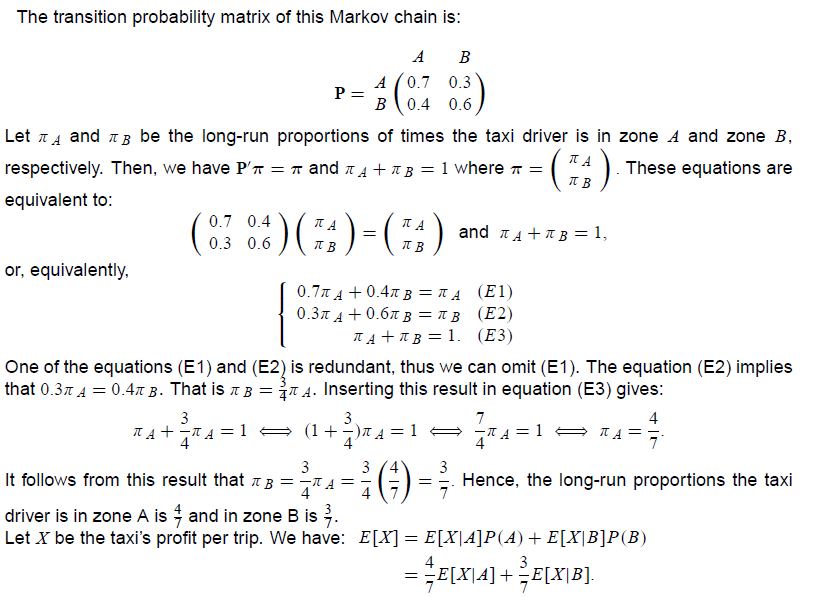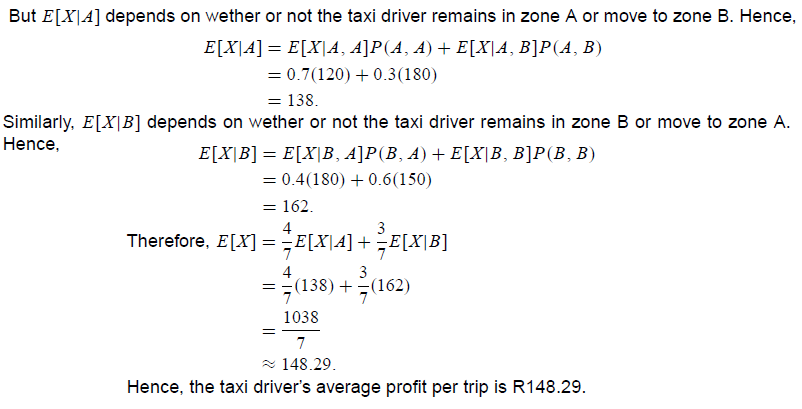

Probability and Stochastic Processes
MARKOV CHAIN
The transition probability matrix of this Markov chain is: A B P = A 0.7 0.3 B 0.4 0.6 Let A and a be the long-run proportions of times the taxi driver is in zone A and zone B, respectively. Then, we have P'7 = 7 and x A + IB = 1 where T = It A These equations are A B equivalent to: 03 0.6) ( 74 ) - (26 and ATAB = 1, or, equivalently, 0. 71 A + 0.4A B = NA (E1) 0. 31 A + 0.6A B = 1B (E2) KA+AB = 1. (E3) One of the equations (E1) and (E2) is redundant, thus we can omit (E1). The equation (E2) implies that 0.3x A = 0.4x B. That is a B = 1 4. Inserting this result in equation (E3) gives: 3 RAT-RA=1 - (1+=)MA=1- 7 -MA =1 -> AA= 3 It follows from this result that . B = - A = Hence, the long-run proportions the taxi driver is in zone A is = and in zone B is . Let X be the taxi's profit per trip. We have: E[X] = E[X|A]P(A) + E[X\\B]P(B) = =E[X|A] + =E[X|B].But E[X'| A] depends on wether or not the taxi driver remains in zone A or move to zone B. Hence, E[X| A] = E[XIA, A]P(A, A) + E[X|A, B]P(A, B) = 0.7(120) + 0.3(180) = 138. Similarly, E[X"|B] depends on wether or not the taxi driver remains in zone B or move to zone A. Hence, E[X|B] = E[X|B, A]P(B, A) + E[X\\B, B]P(B, B) = 0.4(180) + 0.6(150) = 162. 4 Therefore, E[X] = = E[XIA] + =E[X|B] 3 = (138) + =(162) 1038 = 7 148.29. Hence, the taxi driver's average profit per trip is R148.29.QUESTION 4 A taxi driver provides service in three zones of a city. Fares picked in zone A will have destination in zone A with probability 0.4 or in zone B with probability 0.3 or in zone C with probability 0.3. Fares picked in zone B will have destination in zone A with probability 0.2 or in zone B with probability 0.7 or in zone C with probability 0.1. Fares picked in zone C will have destination in zone A with probability 0.3 or in zone B with probability 0.2 or in zone C with probability 0.5. The driver's expected profit for a trip entirely in zone A is R200; for a trip entirely in zone B is R150; for a trip entirely in zone C is R180; and for a trip that involves zones A and B is R160; for a trip that involves zones A and C is R170; and for a trip that involves zones B and C is R140. Find the taxi driver's average profit per trip. [24] QUES TION 6 A taxi driver provides service in two zones of a city. Fares picked in zone A will have destination in zone A with probability 0.7 or in zone B with probability 0.3. Fares picked in zone B will have destination in zone A with probability 0.4 or in zone B with probability 0.6. The driver's expected profit for a trip entirely in zone A is R120; for a trip entirely in zone B is R150; and for a trip that involves both zones is R180. Find the taxi driver's average profit per trip












